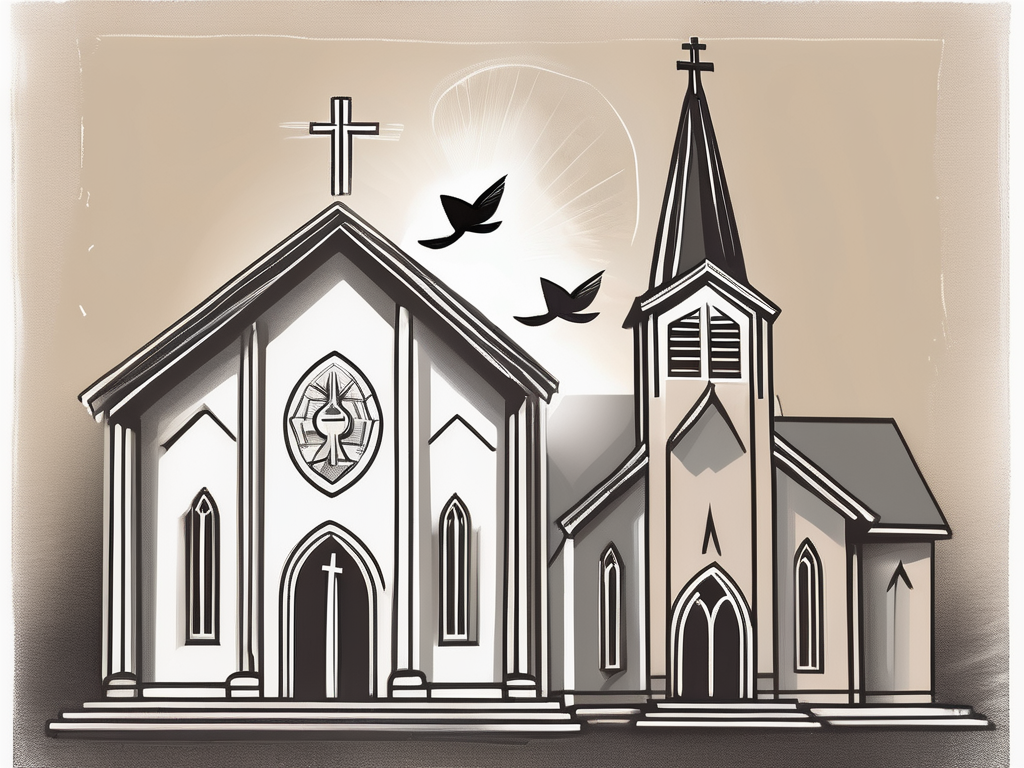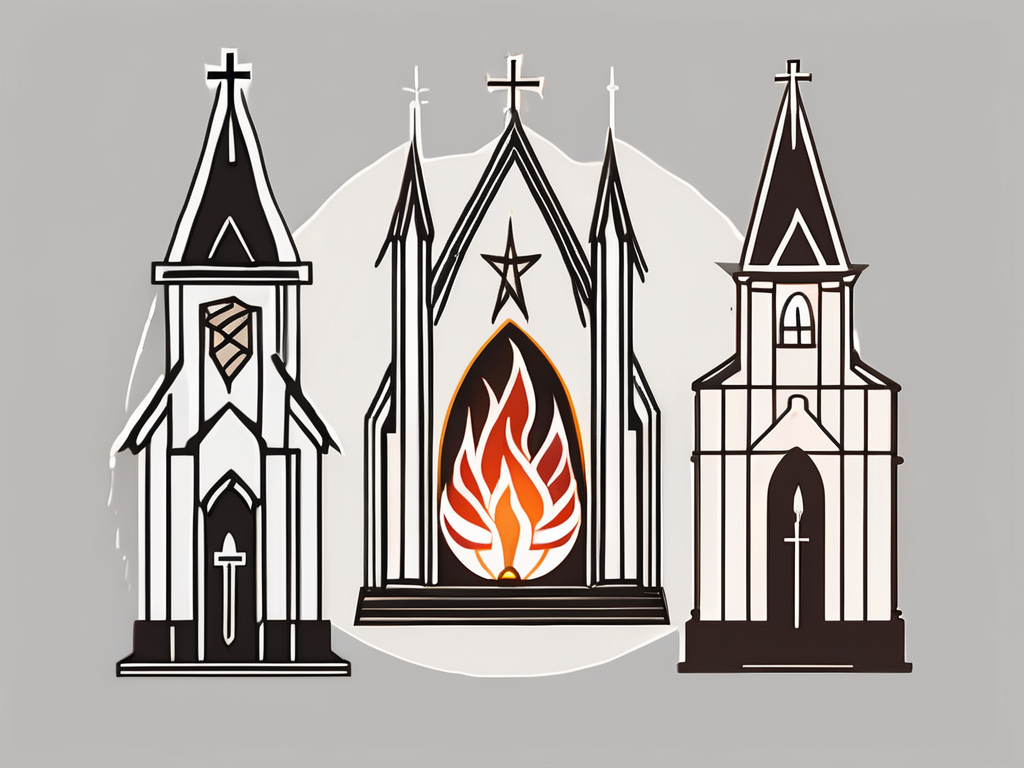In the realm of Christianity, there are various denominations that have their own unique beliefs, practices, and worship styles. Two major branches are Protestantism and Pentecostalism. While they both fall under the umbrella of Christianity, they differ in many aspects. Let’s take a closer look at these two traditions to better understand their similarities and differences.
Understanding the Basics: What is Protestantism?
Protestantism emerged during the 16th century as a reform movement within Christianity. It was a response to what many saw as the corruption and abuses of the Roman Catholic Church at the time. The movement gained momentum as individuals sought to challenge the established religious hierarchy and promote a return to the core teachings of Christianity.
Protestants believe in the authority of the Bible as the ultimate religious text and emphasize individual faith and salvation. They reject certain Catholic doctrines such as papal authority and the veneration of saints. This rejection of traditional practices and beliefs led to a significant shift in the religious landscape of Europe during the Reformation.
Key Beliefs and Practices of Protestants
Protestants hold several key beliefs that distinguish them from other Christian denominations. One of these beliefs is the concept of sola scriptura, which means that the Bible alone is the sole authority for faith and practice. This emphasis on scripture as the ultimate source of religious guidance reflects the desire to strip away the layers of tradition and human interpretation that had accumulated within the Catholic Church.
Another fundamental belief among Protestants is justification by faith alone. This doctrine emphasizes that salvation is granted through personal faith in Jesus Christ rather than through the performance of good works or adherence to religious rituals. This emphasis on personal faith and direct relationship with God resonated with many individuals who felt burdened by the complex system of sacraments and penances within Catholicism.
Furthermore, Protestants uphold the principle of the priesthood of all believers. This belief asserts that every Christian has direct access to God through prayer and does not require a mediator, such as a priest, to intercede on their behalf. This democratization of religious authority challenged the hierarchical structure of the Catholic Church and empowered individuals to take ownership of their spiritual lives.
The Historical Roots of Protestantism
Protestantism traces its origins back to figures such as Martin Luther, John Calvin, and Huldrych Zwingli. These reformers, driven by their deep dissatisfaction with the state of the Catholic Church, sought to challenge the corruption within its ranks and promote a return to the teachings of the early Christian Church.
Martin Luther, a German monk, is often credited with sparking the Protestant Reformation. In 1517, he famously nailed his Ninety-Five Theses to the door of the Castle Church in Wittenberg, Germany, criticizing the sale of indulgences and other abuses within the Catholic Church. Luther’s actions ignited a firestorm of debate and dissent, leading to a widespread movement of religious and social change across Europe.
John Calvin, a French theologian, played a significant role in shaping Protestant theology. His teachings emphasized the sovereignty of God, predestination, and the importance of living a righteous life. Calvin’s ideas, which spread through his writings and the establishment of Reformed churches, had a lasting impact on Protestantism and influenced the development of various denominations.
Huldrych Zwingli, a Swiss pastor, also contributed to the formation of Protestantism. He advocated for the removal of religious images and symbols from churches, rejecting what he saw as idolatry and superstition. Zwingli’s teachings, centered on the primacy of scripture and the simplicity of worship, laid the foundation for the development of the Swiss Reformed tradition.
Overall, the historical roots of Protestantism are deeply intertwined with the desire for religious reform and a return to the core principles of Christianity. The actions and teachings of individuals like Luther, Calvin, and Zwingli set in motion a transformative movement that continues to shape the religious landscape to this day.
Delving into Pentecostalism
Pentecostalism emerged in the late 19th century as a renewal movement within Christianity. It places a strong emphasis on the empowering presence of the Holy Spirit in the lives of believers. Pentecostals believe in the gifts of the Holy Spirit, including speaking in tongues, divine healing, and prophecy. They believe that these spiritual gifts are available to all believers today.
Pentecostalism is a vibrant and dynamic branch of Christianity that has had a profound impact on the religious landscape. With its emphasis on the supernatural and the direct experience of God’s power, Pentecostalism has attracted millions of followers around the world. Let’s delve deeper into the fundamental tenets and the birth of this influential movement.
The Fundamental Tenets of Pentecostalism
Pentecostals believe in the importance of a personal conversion experience and salvation through faith in Jesus Christ. They highlight the baptism of the Holy Spirit, which they believe grants believers power and spiritual gifts. The doctrine of speaking in tongues, also known as glossolalia, holds a central place in Pentecostal worship practices.
The experience of speaking in tongues is seen as a sign of the Holy Spirit’s presence and an expression of deep spiritual connection. It is believed to be a heavenly language that allows believers to communicate directly with God. This practice is often accompanied by intense emotions, fervent prayers, and a sense of divine communion.
Divine healing is another core belief in Pentecostalism. Pentecostals believe that God can intervene in the physical realm and bring about miraculous healings. They view illness and disease as manifestations of spiritual and emotional imbalances, and through prayer and faith, they seek healing for both the body and the soul.
The Birth and Growth of Pentecostalism
Pentecostalism can be traced back to the Azusa Street Revival in Los Angeles in 1906, led by William J. Seymour. This event marked the beginning of the modern Pentecostal movement. The Azusa Street Revival was characterized by intense spiritual experiences, including speaking in tongues, healings, and prophecies.
The revival quickly gained attention and attracted people from various racial and social backgrounds, breaking down barriers and fostering a sense of unity among believers. The Azusa Street Revival became a catalyst for the spread of Pentecostalism, not only in the United States but also around the world.
Pentecostalism’s growth was fueled by the enthusiasm and dedication of its followers. Missionaries traveled to different countries, spreading the message of Pentecostalism and establishing churches. The movement found fertile ground in places where traditional religious practices were already prevalent, as Pentecostalism offered a more experiential and emotionally charged form of worship.
Throughout the 20th century, Pentecostalism continued to expand, influencing not only Christianity but also other religious traditions. Its impact can be seen in the rise of charismatic and neo-Pentecostal movements, which share many of the same beliefs and practices.
Today, Pentecostalism is a global phenomenon, with millions of adherents across continents. It has become one of the fastest-growing religious movements, particularly in the Global South. Pentecostal churches are known for their lively worship services, where believers gather to experience the power of the Holy Spirit through singing, dancing, and fervent prayer.
In conclusion, Pentecostalism is a vibrant and influential movement within Christianity. Its emphasis on the Holy Spirit’s presence, spiritual gifts, and direct experiences with God has resonated with believers around the world. From its humble beginnings at the Azusa Street Revival to its global reach today, Pentecostalism continues to shape the religious landscape and provide a spiritual home for millions of individuals seeking a deeper connection with the divine.
Comparing Protestant and Pentecostal Beliefs
While Protestantism and Pentecostalism share common roots in Christianity, they have distinct beliefs that set them apart from each other.
Protestantism, which emerged during the Reformation in the 16th century, encompasses a wide range of denominations and theological perspectives. It emphasizes the authority of Scripture and the doctrine of justification by faith alone. Protestants believe in the Trinity, the divinity of Jesus Christ, and the importance of personal moral conduct. They also affirm the centrality of the Bible as the inspired word of God.
Pentecostalism, on the other hand, is a relatively newer movement that originated in the early 20th century. It places a strong emphasis on the work of the Holy Spirit and the experience of spiritual gifts. Pentecostals believe in the Trinity and the divinity of Jesus Christ, but they go further by emphasizing the baptism of the Holy Spirit as a distinct experience subsequent to salvation.
Similarities in Doctrine and Practice
Both Protestantism and Pentecostalism share common ground in their core beliefs. They both affirm the existence of one God in three persons: the Father, the Son, and the Holy Spirit. They believe in the divinity of Jesus Christ, that He is the Son of God who came to earth, died for humanity’s sins, and rose from the dead. Both traditions also emphasize the importance of personal moral conduct and living a life that reflects the teachings of Jesus.
Furthermore, both Protestantism and Pentecostalism hold the Bible in high regard as the inspired word of God. They believe that the Scriptures contain the ultimate authority for faith and practice, and they seek to interpret and apply its teachings in their daily lives.
Distinctive Beliefs: Where They Differ
While there are many similarities between Protestantism and Pentecostalism, there are also significant differences that set them apart.
One major difference between the two traditions lies in the manifestation of spiritual gifts. While some Protestant denominations may embrace the gifts of the Holy Spirit, Pentecostalism places a greater emphasis on these gifts, considering them as evidence of the baptism of the Holy Spirit. Pentecostals believe that the Holy Spirit empowers believers with various gifts, such as speaking in tongues, prophecy, healing, and miracles. They view these gifts as essential for the edification and growth of the Church.
Additionally, Pentecostal worship tends to be more experiential and charismatic. It often involves lively music, spontaneous prayers, and emotional expressions of faith. Pentecostals believe in the active presence of the Holy Spirit in their worship services, and they seek to create an atmosphere where believers can experience the power and presence of God in a tangible way.
Protestant worship, on the other hand, can vary greatly depending on the denomination and tradition. Some Protestant churches may have a more formal and structured worship style, while others may adopt a more contemporary and casual approach. The emphasis in Protestant worship is typically on the preaching and teaching of the Word of God, with an aim to educate and inspire believers.
It is important to note that while these differences exist, there is also diversity within both Protestantism and Pentecostalism. Not all Protestants or Pentecostals adhere to the same beliefs and practices, and there is room for individual interpretation and variation within each tradition.
Worship Styles: A Comparative Analysis
The way in which Protestants and Pentecostals worship also reflects their theological differences.
Protestant Worship: A Closer Look
Protestant worship services vary widely, depending on the denomination and geographical location. However, they typically include elements such as prayers, hymns, Bible readings, sermons, and communal activities. The worship experience tends to be more structured and formal.
Pentecostal Worship: An In-depth Examination
In contrast, Pentecostal worship is characterized by a fervent, spontaneous style. It often includes energetic singing, clapping, dancing, and the use of musical instruments. Worshipers may engage in personal prayer and the laying on of hands for healing. It’s not uncommon to witness individuals speaking in tongues or prophesying during the service.
The Role of the Bible in Protestant and Pentecostal Traditions
Both Protestantism and Pentecostalism hold a high regard for the Bible, but their approaches to biblical interpretation differ.
Protestant Interpretations of the Bible
Protestants generally interpret the Bible using a historical-grammatical method, seeking to understand the original context and intended meaning of the text. They often view the Bible as a guide for personal faith and practical living.
Pentecostal Views on Biblical Authority
Pentecostals, while also valuing the historical-grammatical approach, emphasize the direct guidance of the Holy Spirit in interpreting the Bible. They believe that the Spirit illuminates the Scriptures and provides insight and revelation beyond the literal text.
In conclusion, the differences between Pentecostalism and Protestantism are rooted in their historical origins, beliefs, worship styles, and approaches to the Bible. By understanding these differences, we can appreciate the diverse expressions of faith within the Christian tradition and foster greater understanding and respect among believers.












